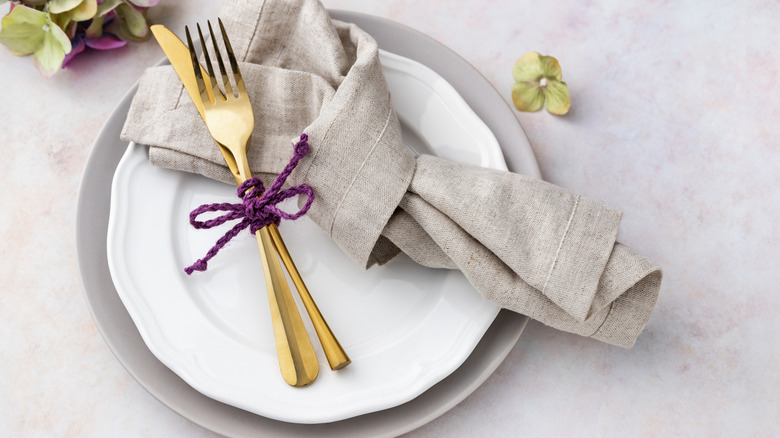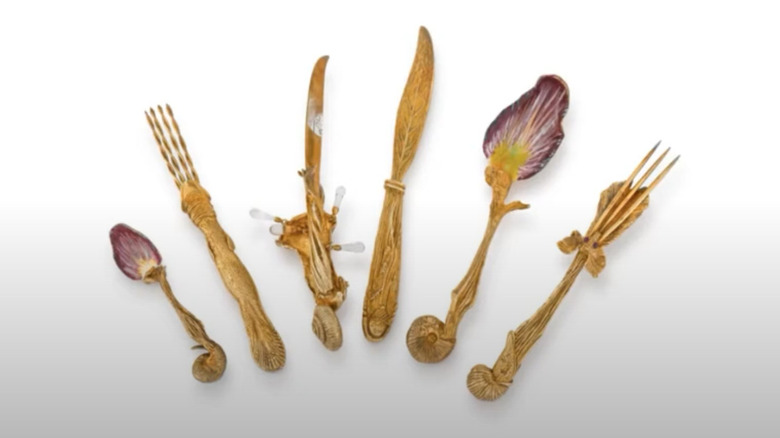This Once-Dated Trend Is Making Cutlery The Star Of The Table Again
Quirky. Impractical. Heavy-laden with gems and precious metals. You'd be forgiven for thinking that the preceding list described a queen's crown jewels. It doesn't. It's a take on a dated trend that's being revisited — fancy cutlery, and these days, flatware is truly like jewelry for the table. All of this is thanks to modern jewelry designers who have stopped making baubles for the neck and started making them for the dinner table. This rise of this recent trend seems to have grown out of a couple of disparate influences: the ubiquity of art and design festivals, a greater use of food as an artistic medium, and a desire to take a little breathing time at meals to slow down and just be.
The fancy cutlery trend couldn't have a resurgence if it didn't already have a history, and the history of it goes back a long way. People in the Paleolithic Era may have used seashells as spoons. In China, circa 2400-1900 B.C., bones became forks. Of course, thanks to the ruins in Pompeii, we also know that the Romans loved a good set of fancy utensils. The cutlery did more than allow them to eat. It showed off their wealth and status. Indeed, utensils as decoration and status symbols go back a long, long way in history, it seems.
Merging practicality with beauty
Notably, Salvador Dali took fancy tableware to the next level in the modern era when he created an impressive set of silverware. The pieces were released in 1957 and later went on to sell at auction in 2012 for just over $28,000, per Vogue. Surrealism and the exotic flora and fauna of the world played big roles in Dali's design, which consisted of, amongst other things, some artichoke spoons, an elephant and a fish fork, and a knife inspired by leaves. And as if this fancy design weren't eye-catching enough, the pieces were made of gemstones and precious metals, making them one of the spendier ways to introduce Surrealist art to a home.
Modern cutlery designers might still be inspired by decades-old vintage dinnerware, but they're lending their own artistic voices to the mix, too. The Danish design company, Georg Jensen, for example, works with designers like Noam Griest to produce cutlery whose shapes take their inspiration from nature, just as Dali did.
However, others, like jewelry designer Alighieri Casa, demonstrate to cutlery collectors that not all natural materials come from plants. Rocks and minerals make up a good portion of the world, too, and her designs embrace them. They remind people that life extends beyond the computer screen and that sitting down and taking a breather is a perfectly acceptable way to spend an afternoon.
Cutlery as a social construct
People give a great deal of thought to how their food travels from the table to their mouths. The tools they use for this purpose, utensils, help convey social status and the rules of etiquette, without anyone uttering a word. And while many artisanal designs end up in the personal collections of foodies, the acquisition of them is often inspired by interactions in the public space. Aside from finding the pieces at art and design shows, fancy cutlery lovers gather ideas from the likes of social media, where foodies show off the flatware and dishes of the restaurant they're eating at. These pieces are as much a star of the show as the food is. And speaking of shows, the rise of food TV has prompted an increase in the purchase of chichi dinnerware, including cutlery to the tune of 15% per year, according to Globally Cool. Cutlery inspiration can be found everywhere.
Still, our desire for fancy forks may come from more than just seeing something pretty on Instagram, at a design fair, or on food TV. A 2017 study from Oxford University via Food Navigator found that people like their yogurt better when they eat it with a nicer set of utensils instead of plastic ones. This discovery goes a long way toward explaining why fancy cutlery trends like the one gaining speed today show up again and again throughout history.


